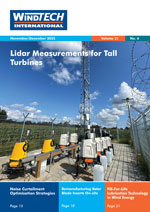- Category: Articles
 At the present time 65% of Sri Lanka's electricity is generated by fossil fuels. In this situation, utilisation of renewable energy for electricity generation is very important to mitigate economic and environmental impacts. Wind energy has been identified as one of the more promising renewable energy sources that could generate electricity in Sri Lanka. However, it will be necessary to improve the quality and accessibility of renewable energy resource data before large-scale wind energy technologies can be developed locally. At present, ground wind measurements are not sufficient to accomplish a comprehensive wind resource assessment in Sri Lanka. For this reason, a high-resolution wind map has been developed by the US National Renewable Energy Laboratory. In this article, cost of wind power generation in various parts of Sri Lanka is discussed and compared to the existing power purchasing tariff system in the country.
At the present time 65% of Sri Lanka's electricity is generated by fossil fuels. In this situation, utilisation of renewable energy for electricity generation is very important to mitigate economic and environmental impacts. Wind energy has been identified as one of the more promising renewable energy sources that could generate electricity in Sri Lanka. However, it will be necessary to improve the quality and accessibility of renewable energy resource data before large-scale wind energy technologies can be developed locally. At present, ground wind measurements are not sufficient to accomplish a comprehensive wind resource assessment in Sri Lanka. For this reason, a high-resolution wind map has been developed by the US National Renewable Energy Laboratory. In this article, cost of wind power generation in various parts of Sri Lanka is discussed and compared to the existing power purchasing tariff system in the country.By Mahinsasa Narayana, National Engineering Research & Development Centre, Sri Lanka
.- Category: Articles
A Vision for Creating a More Powerful Europe
 Airtricity is proposing the development of the Supergrid. This project consists of a series of interconnected offshore wind farms throughout the seas of Europe. It would be commonly owned by all European states, with the wind farms dispersed across a wide geographic area, ranging from the Baltic Sea to the Mediterranean and Atlantic. This broad arrangement could smooth out any intermittency of supply by capturing the wind and transmitting power from one end of the grid to the other to feed into national grids. In the event of the wind not blowing, it would also allow for the movement of brown (non-renewable) power, putting in place an infrastructure for an energy trading system. Supergrid would be implemented in stages, the first being an offshore wind farm in the North Sea called the 10GW Foundation Project. It would demonstrate the project’s feasibility by interconnecting the markets of the UK, the Netherlands and Germany and create economies of scale.
Airtricity is proposing the development of the Supergrid. This project consists of a series of interconnected offshore wind farms throughout the seas of Europe. It would be commonly owned by all European states, with the wind farms dispersed across a wide geographic area, ranging from the Baltic Sea to the Mediterranean and Atlantic. This broad arrangement could smooth out any intermittency of supply by capturing the wind and transmitting power from one end of the grid to the other to feed into national grids. In the event of the wind not blowing, it would also allow for the movement of brown (non-renewable) power, putting in place an infrastructure for an energy trading system. Supergrid would be implemented in stages, the first being an offshore wind farm in the North Sea called the 10GW Foundation Project. It would demonstrate the project’s feasibility by interconnecting the markets of the UK, the Netherlands and Germany and create economies of scale.
By Dr Eddie O’Connor, CEO and founder of Airtricity, Ireland
- Category: Articles
 A multi-scheme ensemble prediction system has been successfully applied to the forecasting of wind energy in the Republic of Ireland. An accurate forecasting ability is critical for the safe, efficient and economical operation of the power system. Accurate forecasting has become particularly important because of the rapidly increasing proportion of wind-generated power in the small, synchronous Irish system and also because of the ?impending Single Electricity Market for the Republic and Northern Ireland. Results are presented here for forecasting the total wind generation of the power system. Geographical dispersion of wind farms and the use of ensemble prediction techniques – which allow? the forecast uncertainty to be quantified – should permit higher penetrations of wind generation on isolated and weakly interconnected power systems.
A multi-scheme ensemble prediction system has been successfully applied to the forecasting of wind energy in the Republic of Ireland. An accurate forecasting ability is critical for the safe, efficient and economical operation of the power system. Accurate forecasting has become particularly important because of the rapidly increasing proportion of wind-generated power in the small, synchronous Irish system and also because of the ?impending Single Electricity Market for the Republic and Northern Ireland. Results are presented here for forecasting the total wind generation of the power system. Geographical dispersion of wind farms and the use of ensemble prediction techniques – which allow? the forecast uncertainty to be quantified – should permit higher penetrations of wind generation on isolated and weakly interconnected power systems.By Steven J. Lang, University College Cork, Ireland
- Category: Articles
What Stock Prices and Wind Loads Have in Common
 Extreme loads that occur only once or a few times in the life of a wind turbine play an important role in the design process. The time series of loads typically look like a mixture of oscillations and random fluctuations, the latter caused by the turbulent wind. From the fluctuating time series we need to be able to determine reliable loads equipped with probabilistic properties like ‘exceeded on average once within 50 years’. For a long time the methods used to determine ultimate loads for wind turbines have been relatively simplistic. However, nowadays, because of increasing turbine size and value, more sophisticated methods are recommended. In this article we give an introduction to extreme value theory that provides the tools to determine ultimate loads and also introduce our computer program GumbelWind as a tool for the practical application of the theory.
Extreme loads that occur only once or a few times in the life of a wind turbine play an important role in the design process. The time series of loads typically look like a mixture of oscillations and random fluctuations, the latter caused by the turbulent wind. From the fluctuating time series we need to be able to determine reliable loads equipped with probabilistic properties like ‘exceeded on average once within 50 years’. For a long time the methods used to determine ultimate loads for wind turbines have been relatively simplistic. However, nowadays, because of increasing turbine size and value, more sophisticated methods are recommended. In this article we give an introduction to extreme value theory that provides the tools to determine ultimate loads and also introduce our computer program GumbelWind as a tool for the practical application of the theory.
By M. Hänler and U. Ritschel, Windrad Engineering GmbH, Germany
- Category: Articles
Identifying Promising Areas for Wind Farm Installation and Energy Prediction
 This article describes the development of a computational tool designed to help the electric power utilities in the planning and operation of a system that integrates wind energy into the electric grid.
This article describes the development of a computational tool designed to help the electric power utilities in the planning and operation of a system that integrates wind energy into the electric grid.- Category: Articles
 Imagine a kite that looks like an aircraft and can be flown like one. An efficient, reliable and stable design. Such a kite is a portable pulling force in the air. With this force it is possible to do all kinds of exciting things such as pull ships and generate energy. At the Delft University of Technology, Faculty of Aerospace Engineering, kites are maturing from ‘toys’ to a serious force to be reckoned with.
Imagine a kite that looks like an aircraft and can be flown like one. An efficient, reliable and stable design. Such a kite is a portable pulling force in the air. With this force it is possible to do all kinds of exciting things such as pull ships and generate energy. At the Delft University of Technology, Faculty of Aerospace Engineering, kites are maturing from ‘toys’ to a serious force to be reckoned with.By Jeroen Breukels, PhD student, and Prof. Dr Wubbo J. Ockels, Chair ASSET, TU-Delft, The Netherlands
- Category: Articles
For many years most modern large wind turbines were erected in areas like Denmark and northern Germany, where earthquakes are rare and normally weak. However, more recently wind farms have been developed in Asia, Africa and southern Europe, where strong earthquakes are much more likely to occur. As a consequence, the question arises as to how wind turbines perform in an earthquake of a given magnitude, and especially to what extent the stability of the overall structure and integrity of the machinery are guaranteed. This article describes how building codes for seismic loading of structures are used for site approvals for wind farms and shows results for the simulated dynamical behaviour of a wind turbine in an earthquake. The simulation has been carried out with the new simulation code SiWEC, which is also introduced in this article.
By M. Hänler, U. Ritschel and I. Warnke, Windrad Engineering GmbH, Germany










